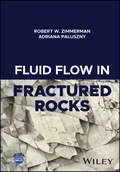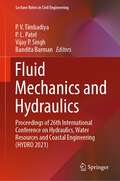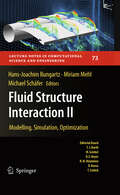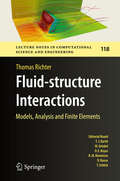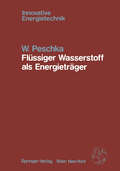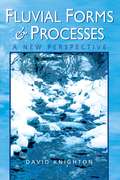- Table View
- List View
Fluid Flow in Fractured Rocks
by Robert W. Zimmerman Adriana PalusznyFLUID FLOW IN FRACTURED ROCKS "The definitive treatise on the subject for many years to come" (Prof. Ruben Juanes, MIT) Authoritative textbook that provides a comprehensive and up-to-date introduction to fluid flow in fractured rocks Fluid Flow in Fractured Rocks provides an authoritative introduction to the topic of fluid flow through single rock fractures and fractured rock masses. This book is intended for readers with interests in hydrogeology, hydrology, water resources, structural geology, reservoir engineering, underground waste disposal, or other fields that involve the flow of fluids through fractured rock masses. Classical and established models and data are presented and carefully explained, and recent computational methodologies and results are also covered. Each chapter includes numerous graphs, schematic diagrams and field photographs, an extensive reference list, and a set of problems, thus providing a comprehensive learning experience that is both mathematically rigorous and accessible. Written by two internationally recognized leaders in the field, Fluid Flow in Fractured Rocks includes information on: Nucleation and growth of fractures in rock, with a multiscale characterization of their geometric traits Effect of normal and shear stresses on the transmissivity of a rock fracture and mathematics of fluid flow through a single rock fracture Solute transport in rocks, with quantitative descriptions of advection, molecular diffusion, and dispersion Fluid Flow in Fractured Rocks is an essential resource for researchers and postgraduate students who are interested in the field of fluid flow through fractured rocks. The text is also highly suitable for professionals working in civil, environmental, and petroleum engineering.
Fluid Flow in Fractured Rocks
by Robert W. Zimmerman Adriana PalusznyFLUID FLOW IN FRACTURED ROCKS "The definitive treatise on the subject for many years to come" (Prof. Ruben Juanes, MIT) Authoritative textbook that provides a comprehensive and up-to-date introduction to fluid flow in fractured rocks Fluid Flow in Fractured Rocks provides an authoritative introduction to the topic of fluid flow through single rock fractures and fractured rock masses. This book is intended for readers with interests in hydrogeology, hydrology, water resources, structural geology, reservoir engineering, underground waste disposal, or other fields that involve the flow of fluids through fractured rock masses. Classical and established models and data are presented and carefully explained, and recent computational methodologies and results are also covered. Each chapter includes numerous graphs, schematic diagrams and field photographs, an extensive reference list, and a set of problems, thus providing a comprehensive learning experience that is both mathematically rigorous and accessible. Written by two internationally recognized leaders in the field, Fluid Flow in Fractured Rocks includes information on: Nucleation and growth of fractures in rock, with a multiscale characterization of their geometric traits Effect of normal and shear stresses on the transmissivity of a rock fracture and mathematics of fluid flow through a single rock fracture Solute transport in rocks, with quantitative descriptions of advection, molecular diffusion, and dispersion Fluid Flow in Fractured Rocks is an essential resource for researchers and postgraduate students who are interested in the field of fluid flow through fractured rocks. The text is also highly suitable for professionals working in civil, environmental, and petroleum engineering.
Fluid Flow in the Subsurface: History, Generalization and Applications of Physical Laws (Theory and Applications of Transport in Porous Media #28)
by Hui-Hai LiuThis book presents a systematic attempt to generalize several fundamental physical laws related to subsurface fluid flow that are important for a number of contemporary applications in the areas of hydrogeology, reservoir engineering and rock mechanics. It also covers the history of discovering these physical laws, their respective scope of validity, and their generalizations or extensions. The physical laws discussed include Darcy’s law, Darcy-Buckingham law and Hooke’s law. Darcy’s law is the fundamental law for subsurface fluid flow. For low-permeability media, it is not always adequate because of the strong fluid–solid interaction. Though the Darcy-Buckingham law is often used for modeling subsurface multiphase flow, it is only valid under the local equilibrium condition. This condition does not hold in many cases, especially when fingering flow occurs. It is well known that subsurface fluid flow is coupled with mechanical deformation of subsurface media; in some applications, this coupling can play a dominant role. The continuum-scale elastic deformation of natural rock, however, does not always follow the traditional form of Hooke’s law.The book also presents applications of the proposed generalizations of the physical laws to several important engineering projects.
Fluid Flow Phenomena: A Numerical Toolkit (Fluid Mechanics and Its Applications #55)
by Paolo OrlandiThis book deals with the simulation of the incompressible Navier-Stokes equations for laminar and turbulent flows. The book is limited to explaining and employing the finite difference method. It furnishes a large number of source codes which permit to play with the Navier-Stokes equations and to understand the complex physics related to fluid mechanics. Numerical simulations are useful tools to understand the complexity of the flows, which often is difficult to derive from laboratory experiments. This book, then, can be very useful to scholars doing laboratory experiments, since they often do not have extra time to study the large variety of numerical methods; furthermore they cannot spend more time in transferring one of the methods into a computer language. By means of numerical simulations, for example, insights into the vorticity field can be obtained which are difficult to obtain by measurements. This book can be used by graduate as well as undergraduate students while reading books on theoretical fluid mechanics; it teaches how to simulate the dynamics of flow fields on personal computers. This will provide a better way of understanding the theory. Two chapters on Large Eddy Simulations have been included, since this is a methodology that in the near future will allow more universal turbulence models for practical applications. The direct simulation of the Navier-Stokes equations (DNS) is simple by finite-differences, that are satisfactory to reproduce the dynamics of turbulent flows. A large part of the book is devoted to the study of homogeneous and wall turbulent flows. In the second chapter the elementary concept of finite difference is given to solve parabolic and elliptical partial differential equations. In successive chapters the 1D, 2D, and 3D Navier-Stokes equations are solved in Cartesian and cylindrical coordinates. Finally, Large Eddy Simulations are performed to check the importance of the subgrid scale models. Results for turbulent and laminar flows are discussed, with particular emphasis on vortex dynamics. This volume will be of interest to graduate students and researchers wanting to compare experiments and numerical simulations, and to workers in the mechanical and aeronautic industries.
Fluid Injection in Deformable Geological Formations: Energy Related Issues
by Benjamin LoretThis book offers an introduction to the geomechanical issues raised by both the extraction of actual and potential energy resources, and by the treatment of the ensuing environmental concerns. Discussions of the operations of injection of fluids into, and withdrawal from, geological formations link the chapters, each devoted to a particular technical aspect or scientific issue, or to a particular energy resource.Subjects are ordered according to their industrial applications, including enhanced oil and gas recovery, gas hydrates, enhanced geothermal systems, hydraulic fracturing, and carbon dioxide sequestration. An overview of the industrial, research and simulation aspects for each subject is provided. Fluid Injection in Deformable Geological Formations will be of interest to academic and industrial researchers in a wide variety of fields, including computational mechanics, civil engineering, geotechnical engineering and geomechanics, engineering seismology, petroleum engineering, reservoir engineering, and engineering geology.
Fluid Mechanics: An Introduction to the Theory of Fluid Flows
by Franz DurstFluid mechanics embraces engineering, science, and medicine. This book’s logical organization begins with an introductory chapter summarizing the history of fluid mechanics and then moves on to the essential mathematics and physics needed to understand and work in fluid mechanics. Analytical treatments are based on the Navier-Stokes equations. The book also fully addresses the numerical and experimental methods applied to flows. This text is specifically written to meet the needs of students in engineering and science. Overall, readers get a sound introduction to fluid mechanics.
Fluid Mechanics and Hydraulics: Proceedings of 26th International Conference on Hydraulics, Water Resources and Coastal Engineering (HYDRO 2021) (Lecture Notes in Civil Engineering #314)
by P. V. Timbadiya P. L. Patel Vijay P. Singh Bandita BarmanThis book comprises the proceedings of the 26th International Conference on Hydraulics, Water Resources and Coastal Engineering (HYDRO 2021) focusing on broad spectrum of emerging opportunities and challenges in the field of fluid mechanics and hydraulics. It covers a range of topics, including, but not limited to, experimental and computational fluid mechanics, sediment dynamics, environmental impact assessment of water resources projects, environmental flows, pollutant transport, etc. Presenting recent advances in the form of illustrations, tables, and text, it offers readers insights for their own research. In addition, the book addresses fundamental concepts and studies in the field of flood forecasting and hydraulic structures, making it a valuable resource for both beginners and researchers wanting to further their understanding of hydraulics, water resources and coastal engineering.
Fluid Mechanics and the Environment: A Collection of Research Papers Written in Commemoration of the 60th Birthday of Sidney Leibovich (Lecture Notes in Physics #566)
by John L. LumleyThe papers in this volume were written by his students and colleagues to honor Sidney Leibovich, Samuel B. Eckert Professor in the Sibley School of Mechanical and Aerospace Engineering at Cornell University, in commemoration of his 60th birthday, 2 April 1999. They were presented at a symposium held at Cornell, 23 and 24 August 1999. Sid obtained his Bachelor of Science degree with honors from The California Institute of Technology in 1961, graduating first in his class. He came to Cornell to work with Geoffrey Ludford on Magnetohydrodynamics, and obtained his Ph.D. in 1965 in the Department of Theoretical and Applied Mechanics. He spent a year at University College, London as a NATO Postdoctoral Fellow, and returned to Cornell as an Assistant Professor. He has been here ever since, and is currently Director of the Sibley School. Since returning to Cornell, Sid has concentrated on rotating fluids and n- linear waves, in various combinations and applications, producing some 3.2 - pers a year with an applied-mathematical bent. In particular this interest led to both Langmuir circulation and vortex breakdown, two areas in which Sid has had enormous influence, and both, of course, examples of rotating fluids interacting with waves. It was impossible to work in this area without being distracted by the study of the nonlinear dispersive and dissipative waves themselves, and Sid has made substantial contributions in this area.
Fluid Mechanics for Marine Ecologists
by Stanislaw R. MasselShowing marine ecologists, oceanographers and marine engineers how ocean waters interact with, influence and constrain life in the ocean, this package makes the physical processes intelligible to biologists with a modicum of mathematics. Part I of the book examines classical fluid mechanics such as laminar and turbulent flow, boundary layers, and forces induced by flow. Part II deals with large-scale flows, such as waves, large ocean currents, and tides, which are beyond the scope of classic fluid mechanics. In Part III, the link between hydrodynamics of ocean flows and marine ecology is demonstrated by examples of well-established phenomena and processes. The CD-ROM contains 12 ready-to-use computer programs on the calculation, representation and simulation of various processes.
Fluid Mechanics Fundamentals of Hydrocyclones and Its Applications in the Mining Industry (Fluid Mechanics and Its Applications #126)
by Fernando Concha A. Juan Luis Bouso A.This book covers topics on engineering science, technology and applications of the classification of particles in liquids suspensions in hydrocyclones. It is divided into 12 chapters starting with the introduction of the hydrocyclone to the mining industry and its several applications of classification, followed by the fundamentals of classification. A special chapter on the fundamentals of sedimentation as the mechanism of the hydrocyclone classification is given. The authors also cover the fundamentals hydrodynamics of solid–fluid interaction with application to the fluids and suspensions flow of in circular pipelines and discusses the flow pattern in hydrocyclones from a fluid dynamics point of view. The physical design, the empirical, phenomenological and numerical hydrocyclone models are presented. The two last chapters deal with the applications of hydrocyclones system design and instrumentation study cases of application in hydrocyclones to the mining industry. Several parts of this book are the result of the work of their research and professional groups from the university and industry.
Fluid Mechanics of Planets and Stars (CISM International Centre for Mechanical Sciences #595)
by Michael Le Bars Daniel LecoanetThis book explores the dynamics of planetary and stellar fluid layers, including atmospheres, oceans, iron cores, and convective and radiative zones in stars, describing the different theoretical, computational and experimental methods used to study these problems in fluid mechanics, including the advantages and limitations of each method for different problems. This scientific domain is by nature interdisciplinary and multi-method, but while much effort has been devoted to solving open questions within the various fields of mechanics, applied mathematics, physics, earth sciences and astrophysics, and while much progress has been made within each domain using theoretical, numerical and experimental approaches, cross-fertilizations have remained marginal. Going beyond the state of the art, the book provides readers with a global introduction and an up-to-date overview of relevant studies, fully addressing the wide range of disciplines and methods involved. The content builds on the CISM course “Fluid mechanics of planets and stars”, held in April 2018, which was part of the research project FLUDYCO, supported by the European Research Council (ERC) under the European Union's Horizon 2020 research and innovation program.
Fluid Movements — Element Transport and the Composition of the Deep Crust (Nato Science Series C: #281)
by David BridgwaterMany geologists have an equivocal attitude to fluid movements within the crust and the associated changes in the chemical and physical properties of crustal rocks. The controversies earlier this centuary between the "soaks" and the "pontiffs" memorably summarised by H. H. Read (1957) in The Granite Controversy have largely been resolved. Few would now advocate the formation of large granitic bodies by in situ transformation of pre-existing crust as the result of the passage of ichors without the formation of a granitic melt. To many geochemists fluid transport and metasomatism have become slightly suspect processes which at the most locally disturb the primary geochemical and isotopic signatures. While there is common agreement that there are marked differences in the composition of the lower and upper crust, the role of fluid movement as one of the controls of this differentiation is often neglected in favour of suggested primary differences in the composition of igneous rocks emplaced at different depths. Selective fluid transport however provides many geologists with their livelyhood. Without the secondary concentration of commercially important elements by fluids within the crust the mining industry, geological science and human activities based on their products would be very different.
Fluid Physics in Geology: An Introduction to Fluid Motions on Earth's Surface and within Its Crust
by David Jon FurbishFluid Physics in Geology is aimed at geology students who are interested in understanding fluid behavior and motion in the context of a wide variety of geological problems, and who wish to pursue related work in fluid physics. The book provides an introductory treatment of the physical and dynamical behaviors of fluids by focusing first on how fluids behave in a general way, then looking more specifically at how they are involved in certain geological processes. The text is written so students may concentrate on the sections that are most relevant to their own needs. Helpful problems following each chapter illustrate applications of the material to realistic problems involving groundwater flows, magma dynamics, open-channel flows, and thermal convection. Fluid Physics in Geology is ideal for graduate courses in all areas of geology, including hydrology, geomorphology, sedimentology, and petrology.
Fluid-Structure Interaction: Modelling, Simulation, Optimisation (Lecture Notes in Computational Science and Engineering #53)
by Hans-Joachim Bungartz Michael SchäferThis volume in the series Lecture Notes in Computational Science and Engineering presents a collection of papers presented at the International Workshop on FSI, held in October 2005 in Hohenwart and organized by DFG's Research Unit 493 "FSI: Modeling, Simulation, and Optimization". The papers address partitioned and monolithic coupling approaches, methodical issues and applications, and discuss FSI from the mathematical, informatics, and engineering points of view.
Fluid-Structure Interaction and Biomedical Applications (Advances in Mathematical Fluid Mechanics)
by Tomáš Bodnár Giovanni P. Galdi Šárka NečasováThis book presents, in a methodical way, updated and comprehensive descriptions and analyses of some of the most relevant problems in the context of fluid-structure interaction (FSI). Generally speaking, FSI is among the most popular and intriguing problems in applied sciences and includes industrial as well as biological applications. Various fundamental aspects of FSI are addressed from different perspectives, with a focus on biomedical applications. More specifically, the book presents a mathematical analysis of basic questions like the well-posedness of the relevant initial and boundary value problems, as well as the modeling and the numerical simulation of a number of fundamental phenomena related to human biology. These latter research topics include blood flow in arteries and veins, blood coagulation and speech modeling. We believe that the variety of the topics discussed, along with the different approaches used to address and solve the corresponding problems, will help readers to develop a more holistic view of the latest findings on the subject, and of the relevant open questions. For the same reason we expect the book to become a trusted companion for researchers from diverse disciplines, such as mathematics, physics, mathematical biology, bioengineering and medicine.
Fluid Structure Interaction II: Modelling, Simulation, Optimization (Lecture Notes in Computational Science and Engineering #73)
by Hans-Joachim Bungartz Miriam Mehl Michael SchäferFluid-structure interactions (FSI), i.e., the interplay of some moveable or deformable structure with an internal or surrounding fluid, are among the most widespread and most challenging coupled or multi-physics problems. Although much has been accomplished in developing good computational FSI methods and despite convincing solutions to a number of classes of problems including those presented in this book, there is a need for more comprehensive studies showing that the computational methods proposed are reliable, robust, and efficient beyond the classes of problems they have successfully been applied to.This volume of LNCSE, a sequel to vol. 53, which contained, among others, the first numerical benchmark for FSI problems and has received considerable attention since then, presents a collection of papers from the "First International Workshop on Computational Engineering - special focus FSI," held in Herrsching in October 2009 and organized by three DFG-funded consortia. The papers address all relevant aspects of FSI simulation and discuss FSI from the mathematical, informatical, and engineering perspective.
Fluid-Structure Interaction of Composite Structures (Springer Tracts in Mechanical Engineering)
by Young W. KwonThis is the first book presenting dynamic responses and failure of polymer composite structures as they interact with internal and/or external fluid media. It summarizes authoritative research carried out by the author in the past decade on various aspects of Fluid-Structure Interaction (FSI) to present important effects of FSI on composite structures. The topics include impact loading on composite structures with air-back, water-back, or containing water; FSI effects on frequencies, mode shapes, and modal curvatures; cyclic loading for fatigue failure with FSI; coupling of independent composite structures by fluid media; and moving composite structures in water. Numerical techniques for FSI are also presented. Research was conducted both experimentally and numerically to complement each other. The book offers a timely, comprehensive information to fluid-structure interaction of composite structures for students, researchers or practicing engineers.
Fluid-structure Interactions: Models, Analysis and Finite Elements (Lecture Notes in Computational Science and Engineering #118)
by Thomas RichterThis book starts by introducing the fundamental concepts of mathematical continuum mechanics for fluids and solids and their coupling. Special attention is given to the derivation of variational formulations for the subproblems describing fluid- and solid-mechanics as well as the coupled fluid-structure interaction problem. Two monolithic formulations for fluid-structure interactions are described in detail: the well-established ALE formulation and the modern Fully Eulerian formulation, which can effectively deal with problems featuring large deformation and contact. Further, the book provides details on state-of-the-art discretization schemes for fluid- and solid-mechanics and considers the special needs of coupled problems with interface-tracking and interface-capturing techniques. Lastly, advanced topics like goal-oriented error estimation, multigrid solution and gradient-based optimization schemes are discussed in the context of fluid-structure interaction problems.
Fluid Vortices (Fluid Mechanics and Its Applications #30)
by Sheldon GreenFluid Vortices is a comprehensive, up-to-date, research-level overview covering all salient flows in which fluid vortices play a significant role. The various chapters have been written by specialists from North America, Europe and Asia, making for unsurpassed depth and breadth of coverage. Topics addressed include fundamental vortex flows (mixing layer vortices, vortex rings, wake vortices, vortex stability, etc.), industrial and environmental vortex flows (aero-propulsion system vortices, vortex-structure interaction, atmospheric vortices, computational methods with vortices, etc.), and multiphase vortex flows (free-surface effects, vortex cavitation, and bubble and particle interactions with vortices). The book can also be recommended as an advanced graduate-level supplementary textbook. The first nine chapters of the book are suitable for a one-term course; chapters 10--19 form the basis for a second one-term course.
Fluid—Rock Interactions during Metamorphism (Advances in Physical Geochemistry #5)
by M. L. Crawford J. M. Ferry R. T. Gregory L. S. Hollister R. C. Newton J. Ridley A. B. Thompson J. V. Walther B. J. Wood B.W.D. YardleyThe fifth volume in this series is focused on the chemical and physical interactions between rocks undergoing metamorphism and the fluids that they generate and that pass through them. The recognition that such pro cesses can profoundly affect the course of metamorphism has resulted in a number of recent papers and we consider that it is time for a review by some of the interested parties. We hope our selection of contributors provides an adequate cross section and demonstrates some of the flavor of this rapidly developing field. A cursory examination of the volume will reveal that there are widely divergent opinions on the compositions of metamorphic fluids and on the ways in which they interact physically and chemically with the rocks through which they pass. Since our own views are extensively discussed in Chapters 4 and 8, we leave the reader to determine his own brand of the "truth. " We wish to thank D. Bird, S. Bohlen, D. Carmichael, G. Flowers, C. Foster, C. Graham, E. Perry, J. Selverstone, R. Tracy, J. Valley, and R. Wollast for their chapter reviews. Thanks are also due C. Cheverton for her editorial assistance, and the helpful staff at Springer-Verlag New York.
Fluids in the Crust: Equilibrium and transport properties
by K. Shmulovich B. W. Yardley G. GoncharFor much of the 20th century, scientific contacts between the Soviet Union and western countries were few and far between, and often super ficial. In earth sciences, ideas and data were slow to cross the Iron Curtain, and there was considerable mutual mistrust of diverging scient ific philosophies. In geochemistry, most western scientists were slow to appreciate the advances being made in the Soviet Union by os. Korz hinskii, who put the study of ore genesis on a rigorous thermodynamic basis as early as the 1930s. Korzhinskii appreciated that the most fun damental requirement for the application of quantitative models is data on mineral and fluid behaviour at the elevated pressures and temper atures that occur in the Earth's crust. He began the work at the Institute of Experimental Mineralogy (IEM) in 1965, and it became a separate establishment of the Academy of Sciences in Chernogolovka in 1969. The aim was to initiate a major programme of high P-T experimental studies to apply physical chemistry and thermodynamics to resolving geological problems. For many years, Chernogolovka was a closed city, and western scient ists were unable to visit the laboratories, but with the advent of peres troika in 1989, the first groups of visitors were eagerly welcomed to the IEM. What they found was an experimental facility on a massive scale, with 300 staff, including 80 researchers and most of the rest pro viding technical support.
Flußeinträge und Konzentrationen von Phosphor und Stickstoff und das Phytoplankton der Deutschen Bucht. Historische Veränderungen in der Ökologie des Wattenmeeres: 363. Sitzung am 6. Dezember 1989 in Düsseldorf (Rheinisch-Westfälische Akademie der Wissenschaften #382)
by Sebastian A. GerlachFlüssiger Wasserstoff als Energieträger: Technologie und Anwendungen (Innovative Energietechnik)
by W. PeschkaFluvial Depositional Systems: Continuing Education Course Notes 20 (Springer Geology)
by Andrew MiallThis book is intended to complement the author's 1996 book "The geology of fluvial deposits", not to replace it.The book summarizes methods of mapping and interpretation of fluvial depositional systems, with a detailed treatment of the tectonic, climatic and eustatic controls on fluvial depositional processes. It focuses on the preserved, ancient depositional record and emphasizes large-scale (basin-scale) depositional processes. Tectonic and climatic controls of fluvial sedimentation and the effects of base-level change on sequence architecture are discussed. Profusely illustrated and with an extensive reference to the recent literature, this book will be welcomed by the student and professional geologist alike.
Fluvial Forms and Processes: A New Perspective
by David KnightonDavid Knighton's best-selling book looks at the wide range of forms developed by natural rivers and the processes responsible for that development. The book combines empirical and theoretical approaches, and provides a critical assessment of the many schools of thought which have emerged for dealing with adjustment in the fluvial system. It is fully illustrated throughout by a superb range of figures, photographs and tables.Starting with the network scale, the book examines the interaction of hillslopes, drainage networks and channels, and goes on to considerations of catchment hydrology and catchment denudation. Fluvial processes are analysed in detail, from the mechanics of flow to sediment transport and deposition. Detailing the major components of river channels, the book examines the nature of river adjustment, particularly with respect to equilibrium concepts, and concludes with a look at channel changes through time, affected by flood discharges, climatic change and human activities.
